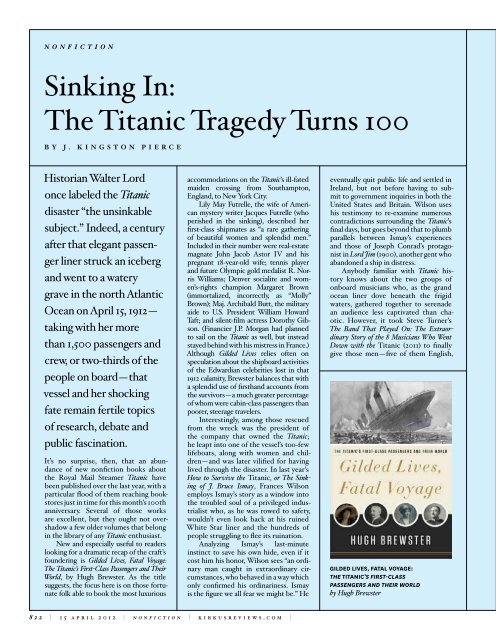nonfiction
nonfiction
nonfiction
Create successful ePaper yourself
Turn your PDF publications into a flip-book with our unique Google optimized e-Paper software.
<strong>nonfiction</strong><br />
Sinking In:<br />
The Titanic Tragedy Turns 100<br />
“Words alone...can’t convey the<br />
complete story of this once-mighty craft.”<br />
BY J. KINGSTON PIERCE<br />
Historian Walter Lord<br />
once labeled the Titanic<br />
disaster “the unsinkable<br />
subject.” Indeed, a century<br />
after that elegant passenger<br />
liner struck an iceberg<br />
and went to a watery<br />
grave in the north Atlantic<br />
Ocean on April 15, 1912—<br />
taking with her more<br />
than 1,500 passengers and<br />
crew, or two-thirds of the<br />
people on board—that<br />
vessel and her shocking<br />
fate remain fertile topics<br />
of research, debate and<br />
public fascination.<br />
It’s no surprise, then, that an abundance<br />
of new <strong>nonfiction</strong> books about<br />
the Royal Mail Steamer Titanic have<br />
been published over the last year, with a<br />
particular flood of them reaching bookstores<br />
just in time for this month’s 100th<br />
anniversary. Several of those works<br />
are excellent, but they ought not overshadow<br />
a few older volumes that belong<br />
in the library of any Titanic enthusiast.<br />
New and especially useful to readers<br />
looking for a dramatic recap of the craft’s<br />
foundering is Gilded Lives, Fatal Voyage:<br />
The Titanic’s First-Class Passengers and Their<br />
World, by Hugh Brewster. As the title<br />
suggests, the focus here is on those fortunate<br />
folk able to book the most luxurious<br />
accommodations on the Titanic’s ill-fated<br />
maiden crossing from Southampton,<br />
England, to New York City.<br />
Lily May Futrelle, the wife of American<br />
mystery writer Jacques Futrelle (who<br />
perished in the sinking), described her<br />
first-class shipmates as “a rare gathering<br />
of beautiful women and splendid men.”<br />
Included in their number were real-estate<br />
magnate John Jacob Astor IV and his<br />
pregnant 18-year-old wife; tennis player<br />
and future Olympic gold medalist R. Norris<br />
Williams; Denver socialite and women’s-rights<br />
champion Margaret Brown<br />
(immortalized, incorrectly, as “Molly”<br />
Brown); Maj. Archibald Butt, the military<br />
aide to U.S. President William Howard<br />
Taft; and silent-film actress Dorothy Gibson.<br />
(Financier J.P. Morgan had planned<br />
to sail on the Titanic as well, but instead<br />
stayed behind with his mistress in France.)<br />
Although Gilded Lives relies often on<br />
speculation about the shipboard activities<br />
of the Edwardian celebrities lost in that<br />
1912 calamity, Brewster balances that with<br />
a splendid use of firsthand accounts from<br />
the survivors—a much greater percentage<br />
of whom were cabin-class passengers than<br />
poorer, steerage travelers.<br />
Interestingly, among those rescued<br />
from the wreck was the president of<br />
the company that owned the Titanic;<br />
he leapt into one of the vessel’s too-few<br />
lifeboats, along with women and children—and<br />
was later vilified for having<br />
lived through the disaster. In last year’s<br />
How to Survive the Titanic, or The Sinking<br />
of J. Bruce Ismay, Frances Wilson<br />
employs Ismay’s story as a window into<br />
the troubled soul of a privileged industrialist<br />
who, as he was rowed to safety,<br />
wouldn’t even look back at his ruined<br />
White Star liner and the hundreds of<br />
people struggling to flee its ruination.<br />
Analyzing Ismay’s last-minute<br />
instinct to save his own hide, even if it<br />
cost him his honor, Wilson sees “an ordinary<br />
man caught in extraordinary circumstances,<br />
who behaved in a way which<br />
only confirmed his ordinariness. Ismay<br />
is the figure we all fear we might be.” He<br />
eventually quit public life and settled in<br />
Ireland, but not before having to submit<br />
to government inquiries in both the<br />
United States and Britain. Wilson uses<br />
his testimony to re-examine numerous<br />
contradictions surrounding the Titanic’s<br />
final days, but goes beyond that to plumb<br />
parallels between Ismay’s experiences<br />
and those of Joseph Conrad’s protagonist<br />
in Lord Jim (1900), another gent who<br />
abandoned a ship in distress.<br />
Anybody familiar with Titanic history<br />
knows about the two groups of<br />
onboard musicians who, as the grand<br />
ocean liner dove beneath the frigid<br />
waters, gathered together to serenade<br />
an audience less captivated than chaotic.<br />
However, it took Steve Turner’s<br />
The Band That Played On: The Extraordinary<br />
Story of the 8 Musicians Who Went<br />
Down with the Titanic (2011) to finally<br />
give those men—five of them English,<br />
Gilded Lives, Fatal Voyage:<br />
The Titanic’s First-Class<br />
Passengers and Their World<br />
by Hugh Brewster<br />
one French, one Belgian and one Scottish—strong<br />
individual identities.<br />
Turner, a music journalist, tracked down<br />
descendents of the eight instrumentalists<br />
and collected photographs that fit<br />
his middle-class subjects into their time<br />
and give them heroic dimension. Unfortunately,<br />
he cannot answer the burning<br />
questions: Why did those men decide<br />
to perform on the Titanic’s deck that<br />
night And were they still playing as the<br />
ship vanished<br />
If you’re looking for more eyewitness<br />
recollections of the steamer’s destruction,<br />
turn to Titanic: First Accounts. Edited<br />
by Tim Maltin, and released earlier this<br />
year, it features excerpts from books and<br />
newspaper articles penned by the survivors.<br />
It also contains the full text of The<br />
Truth About the Titanic, composed by firstclass<br />
passenger Col. Archibald Gracie IV<br />
following his return to civilization, but<br />
not published until after his passing in<br />
December 1912.<br />
Gracie was washed overboard during<br />
the ship’s plunge; however, he subsequently<br />
found salvation on an upturned<br />
lifeboat. His memories of the scene<br />
following the Titanic’s disappearance<br />
will send a chill up your spine: “[T]here<br />
arose to the sky the most horrible sounds<br />
ever heard by mortal man…The agonizing<br />
cries of death from over a thousand<br />
throats, the wails and groans of the suffering,<br />
the shrieks of the terror-stricken<br />
and the awful gaspings of breath of those<br />
in the last throes of drowning, none of us<br />
will ever forget to our dying day.”<br />
Similarly arresting is Wreck and Sinking<br />
of the Titanic: The Ocean’s Greatest<br />
Disaster, edited by Marshall Everett.<br />
Originally rushed to press in 1912, but<br />
rereleased this year in a handsome edition<br />
with new artwork and an antique<br />
quality, this book includes survivor<br />
remembrances, tributes to the betterknown<br />
figures who went down with the<br />
ship, dramatic re-creations of the sinking’s<br />
key moments, stories about relief<br />
funds raised for the poor immigrants<br />
who managed to live through that<br />
WRECK AND SINKING OF<br />
THE TITANIC: The Ocean’s<br />
Greatest Disaster<br />
by Marshall Everett<br />
maritime horror and even a statement<br />
of remorse (“My heart overflows with<br />
grief for you all…”) from the widow of<br />
Capt. Edward J. Smith, who’s thought to<br />
have remained on his bridge till the end.<br />
Words alone, though, can’t convey<br />
the complete story of this once-mighty<br />
craft. Photographs of the luxurious liner<br />
under sail are hard to come by; most of<br />
them having been shot by a 32-year-old<br />
Jesuit priest named Francis Browne, who<br />
boarded the Titanic in Southampton but<br />
got off with his camera in Ireland, before<br />
the fatal ocean transit. Titanic in Photographs<br />
(2011), by Daniel Klistorner and<br />
Steve Hall with Bruce Beveridge, Scott<br />
Andrews and Art Braunschweiger, contains<br />
Browne’s images, as well as shots<br />
of the steamer’s construction in Belfast<br />
and newspaper photos taken during<br />
its sea trials and stops along the way to<br />
New York. On top of those there’s a set<br />
of color illustrations from the interior of<br />
the Titanic’s sister ship, the Olympic, that<br />
shows in what extravagance White Star<br />
passengers traveled.<br />
It’s easy to feel overwhelmed by the<br />
quantity of books currently available<br />
on this maritime misadventure. Not yet<br />
mentioned is John Maxtone-Graham’s<br />
Titanic Tragedy: A New Look at the Lost<br />
Liner, which addresses a few of the lesscovered<br />
topics associated with the tale,<br />
such as the role of wireless communications<br />
in the steamship’s destiny, the shipyards<br />
where the Titanic and Olympic were<br />
assembled, and the rescue vessel Carpathia,<br />
diverted from a Mediterranean<br />
cruise to the site of the Titanic’s collision,<br />
375 miles off the coast of Newfoundland.<br />
Meanwhile, Steven Biel’s 1996 work,<br />
Down with the Old Canoe (an updated<br />
version of which was recently released),<br />
focuses on how the Titanic calamity was<br />
turned into a cultural symbol, used by<br />
feminists, anti-capitalists and others to<br />
advance their own ideologies, and how<br />
its story has been preserved in films,<br />
books and music.<br />
And of course, it wouldn’t do to forget<br />
Walter Lord’s short but classic 1955<br />
work, A Night to Remember (the basis for<br />
the 1958 film of the same name), which<br />
endeavors to provide a “true minute-byminute”<br />
account of the liner’s abbreviated<br />
maiden journey—though many<br />
details of its doom weren’t understood<br />
until oceanographer Dr. Robert Ballard<br />
finally located the Titanic’s remains in the<br />
mid-1980s. Which brings up one more<br />
book that deserves a place on your bookshelf:<br />
Ballard’s well-illustrated work, The<br />
Discovery of the Titanic (1987).<br />
So many books. Yet these still represent<br />
only the tip of the iceberg.<br />
9<br />
J. Kingston Pierce is both the editor of The<br />
Rap Sheet and the senior editor of January<br />
Magazine.<br />
822 | 15 april 2012 | <strong>nonfiction</strong> | kirkusreviews.com |<br />
| kirkusreviews.com | <strong>nonfiction</strong> | 15 april 2012 | 823






